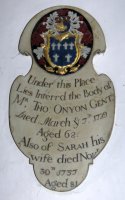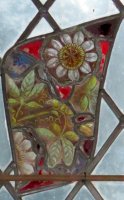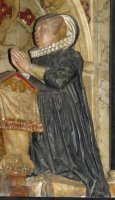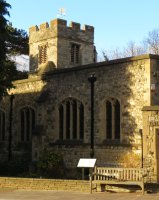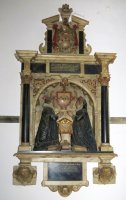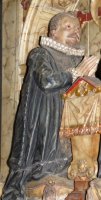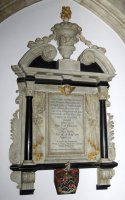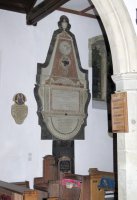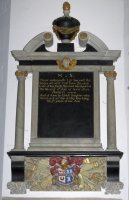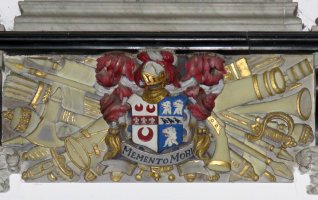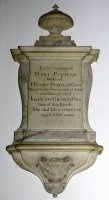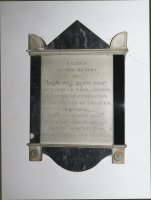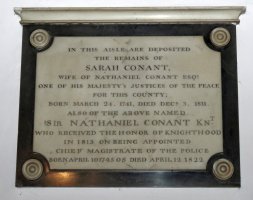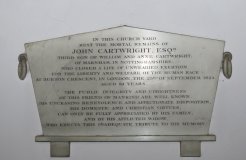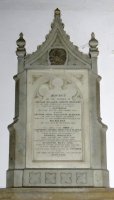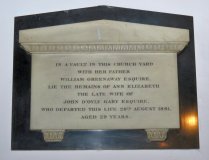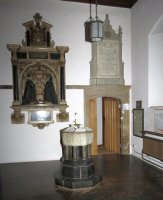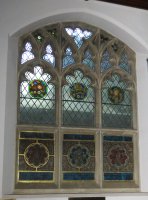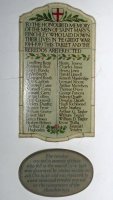Monuments in St Mary at Finchley, North London
St Mary at Finchley, North London, contains three grand wall monuments from the 17th Century, and a selection of lesser panel monuments from the 18th and 19th Centuries.
St Mary at Finchley, North London today but once part of Middlesex, is a modestly sized, low church, without balustrades, though the tower has battlements, and with blocky 20th Century outhouses, lying nestled in its churchyard so that it is not fully in view from any side. Although a church stood here from the 12th Century, what we see today is a mix of 15th/16th Century, 19th Century and early 20th Century work; the recent additions mean that we cannot even see the clerestory windows from the front. Inside feels more cohesive: the dark wooden roof, which is a 15th Century survival, the red and black encaustic tile floor, the several monuments and hatchments on the walls, and the broad arches to the nave all giving character and atmosphere.
St Mary at Finchley.
The monuments we have come to see, almost 20 in all if we include the plainest and humblest panels, are dotted around, mostly on the walls of the aisles, and there are also several brasses. We take them in date order excepting the Allen family, and start with the best. Click any picture to enlarge, or hover for caption.
Monuments
Alexander Kinge MP, d.1618, and his wife Elizabeth [Horspole] King. He was Auditor of the Royal Mint and Exchequer in the times of Queen Elizabeth and King James I. A good example of a kneeler monument, with husband and wife kneeling on tasselled cushions, hands raised in prayer, facing each other over a faldstool [little table for prayer books], with above it their painted arms. They have the ruffs of the period, typical baggy cloaks showing no hint of the figure, and Elizabeth Kinge wears a hood (see picture at top of page, right, click to enlarge). They are framed by a Romanesque arch with black-shafted Corinthian pillars to the sides and an entablature above with the short inscription; on top is his painted shield of arms, in its own mini-aedicule or enclosure, with open pediment and a surmounting skull. At the base is a broad shelf resting on brackets carved with winged cherub heads; a central small panel with a further inscription, and a smaller cherub head below. The monument is not entire, having lost part of the base, which is reconstructed, and lacking whatever urns or obelisks may have been atop the pillars, and the little winged skull at the top likely did not start out in that position, but are very well preserved regardless, and with nice smaller carved features including smaller shields of arms on the spandrels and further cherubs heads under the arch.
The Allen family
There are several panels to the Allen family, from the 17th through to the 19th Centuries. The first of these, Edward Allen, bought the Bibbesworth estate in Finchley, centred on a medieval house which was pulled down by a descendant and replaced with a dull Georgian house.
Edward Allen, d.1626, father of Sir Thomas Allen noted below: a black stone with shield which was on the floor of the Church once.
Sir Thomas Allen of Finchley and Dame Mary.
Sir Thomas Allen of Finchley, d.1681, and his wife Dame Mary [Weld], d.1663, erected by Edward Allen. The second of our grand monuments: an ornate wall panel, white marble with black. Thus the central inscribed panel has a double-border carved with a repeating leaf design, knotted curtains to the sides, black-shafted Corinthian pillars further to the sides, and receding curly side-pieces as a perimeter. A winged cherub head above, then entablature and a curved pediment, open at the top - swan-necked is the term - with a central flaming funereal urn, highly carved with festoons of flowers to the sides. At the base, a lower shelf supported on curly brackets, and a painted central shield of arms. Unusually for a monument of this time, it is signed, Allen fecit [two possibilities, called Edward Allen and Peter Allen, have been proposed as the carver]. The 1680s-90s were typical for this style of monument, and indeed not-dissimilar ones can be seen from earlier generations, excepting that the central inscribed panel would be black rather than white - see the Searle monument noted below.
Thomas Allen, d.1780.
Thomas Allen, d.1780, great grandson of Sir Thomas Allen, above, and his wife Mrs Ann Allen, d.1796. Again really rather splendid, an obelisk monument, of large size and in different coloured marbles. The obelisk, perhaps half the height of the monument, is in a dark red and pink marble, and bears upon it a painted family crest, with pendant below, winged cherub head in front of a sunburst above; it has outer borders of white marble and then streaky black, a pot on the top, and relief carving, including a small Alladin-style lamp below. Such monuments always have a central shelf, and below this is the inscription, with a streaky marble inner border, then broad pilasters carved with pots, portrait heads and wreaths, and outer curls. A semicircular apron added below commemorates their son, also Thomas Allen, d.1830, of Finchley Manor House and Henrietta Street. This has a shell-like border and flowers around it. The whole is most impressive, and is from right at the end of a period of such coloured marble monuments - see this page.
Thomas Allen, his wife Martha Allen, and their son Edward Allen, erected by another son, Thomas Allen. A simple oval with thin border, and an oakleaf design at the top. Undated.
So much for the Allens. Back to chronological order:
The Searle monument.
Lieut. Col. John Searle, d.1682, merchant, and his eldest daughter Anne Searle, d.1681. The third grand panel, and the last of the more ambitious pieces in the Church. The inscription, gilt on black, is within a Carrara marble frame, with free-standing Ionic pillars to the sides, supporting a heavy swan-necked pediment. This encloses a large flaming urn with a carved garland of leaves, and beneath, a winged cherub head. At the base is a large panel bearing the shield of arms, in front of an architectural trophy, thus a group of crossed weapons - canon, blunderbuss, axe, fasces, spear etc - carved in high relief. To the sides, curly brackets resting on leafy carvings. All very impressive.
Mary Pujolas, d.1762.
Mary [Hill] Pujolas, d.1762, wife of Henry Pujolas, ‘Bluemantle Pursuivant at Arras’ - she died just 24 years old. White marble panel with heavy, moulded upper shelf, side pieces and base of streaky marble, a pot on top and a curvy apron below bearing a carved shield of arms.
William Seward, FRS, d.1799, and his parents William and Elizabeth Seward. Plain rimless panel supported on two small blocks. He wrote a 5-volume ‘Anecdotes of Distinguished Persons’ which achieved some distinction itself. It can be read online, and is filled with things such as that Queen Mary wrote a letter to her husband, King William, to dissuade him from retaining a certain Mrs Villiers as his mistress, only to be delivered once the Queen had died.
Thomas Onyon, d.1729, and his wife Sarah Onyon, d.1737. A small panel cut roughly to the shape of a violin body, all curves, with a painted coat of arms at the top; the historian Lysons recorded a tablet to William Onyon, d.1736, outside the Church. See picture at top of page (click to enlarge).
General Richard Smith, d.1803, his wife Amelia Smith, d.1787, and son John Maunsell Smith, d.1827. An upright oval with thin frame.
Sarah Harding, d.1811, and Vincent Harding, d.1812, wife and son of William Harding, the organist of the Parish. Broad oval panel without frame.
John Twemloe, d.1820, the white panel having dark marble with white streaks around: side pieces, a pyramid-shaped top above a wide shelf with acroteria; and at the base, two supporting blocks with a curvey apron, signed by the statuary Thomas Cooke of Fitzroy Square.
Signed white-on-black panels, 1820s (hover for captions).
Sarah Conant, d.1811, and husband Sir Nathaniel Conant, d.1822, Chief Magistrate of the Police. White on black panel, the inscribed rectangle with corners cut out to allow for chequer-piece ornaments; a shelf with moulding above. This modest work is signed by Crake, Portland Road, London. He has several monuments dotted around London and in the surrounding areas, generally quite simple: among those with at least a modicum of ornament is the panel to John Bye, d.1809, in St Giles in the Fields, and one to Charles Price, Baronet, in Richmond. One with the same cut outs as here, but lacking the corner buttons and upper shelf, is to Catharina Henshaw, in Paddington Green.
Anna Fox, with a carving of a draped, egg-shaped funereal urn, acroteria, and a shaped black backing.
Casket end to John Cartwright.
John Cartwright, d.1824, ‘who closed a life of unwearied exertion for the liberty and welfare of the human race at Burton Crescent’, with a eulogy. Cut as a casket end, with outward slanting sides, and two ringlets at the sides, the only sculptural feature. At the base is a protrusion and block feet. No backing panel.
Henrietta Collins, d.1824, and her husband Thomas Collins, d.1830. Plain marble panel with a frame.
Gothic panel to the Oldhams.
Capt. William Joseph Oldham,d.1851, killed in action in Caffreria, and Capt. John Augustin Oldham, d.1854, killed in the charge of the Light Brigade at Balaclava, sons of Leiut. Col. John Field Oldham, d.1860, erected by their sister, Mary Ann Oldham. Victorian times saw the return of the Gothic monument, and this panel is typical - the inscription on a blind Gothic window, with a surround with thin side pilasters bearing flaming urns, a central triangle with curly crocketing, and a heavier base with minor carving, in pale stone and marble. Signed by the stonemason, Bower, who is obscure. A curious feature is the darker stone inset to the triangle carved with an owl amidst flowers.
Charles Jaques, almost entirely covered when I visited so I could not see the inscription, but I would think mid Victorian, being a pale stone Gothic piece with tall, thin pillars and crocketed sides to the sharply-pitched roof above the inscribed panel, which is of the ‘blind window’ type.
Elizabeth [Greenaway] Gaby, d.1869. A tomb chest end, with bulky lid, and the under part of this and the feet are carved with simple repeating patterns. On a black backing - the monument is rather late for this white-on-black style, but a very common design, more so than the earlier Conant and Twemloe panels.
Later white-on-black panels (hover for caption).
Joshua Wimbush, d.1879, and his wife Annie Wimbush, d.1917. Carved as a simple unrolling scroll, on a black backing panel; such scroll designs were a fairly widespread but never common type of white-on black panel monuments.
Lydia Ann Leney, d.1944, a broad oval with a frame, the text being in two colours. This represents the typically modest plaques since World War I effectively brought the era of carved church monuments to an end in all but the most rare cases.
Alexander Kinge, d.1618.
The most ancient monuments are lost from the Church: John Norden, in his Speculum Britanniae, dated 1593, recorded a marble tomb with Lord Chief Justice Frowyke, ‘where hath beene his picture and armes in brasse’, and another to Joan, ‘la feme Thomas de Frowicke’.
Also in the Church
The font, a stone, octagonal bowl with pairs of blind Gothic windows on each face, raised on a central shaft with eight surrounding pillars of dark-coloured stone, with two steps below. The bowl is 12th or early 13th Century, the parts below of presumably 19th Century date, but appropriately styled.
A series of brasses, dating from the late 15th to the early 17th centuries. The earliest is Richard Prate, d.1487, and an unusual one is Simon to Skudemore, d.1609 and his wife, which includes on the same slab his daughter Elizabeth Luke, and husband Nicholas Luke, and offspring.
Several hatchments.
A modest amount of stained glass (see picture below left), including fragmentary ancient pieces (picture at top of page).
Some good woodwork, of varying dates, including a neat pulpit with sounding board, and the screen to the neighbouring aisle.
World War 1 memorial panel to the Men of Finchley, made in glazed tile, with modest floral ornament. Unusual (picture above right).
The font.
The churchyard contains or contained monuments to various worthies of their time, notably an obelisk, brightly restored, to Major John Cartwright, d.1824, political reformer, with a portrait carved in relief.
The Church website is at https://stmaryatfinchley.org.uk/history/.

